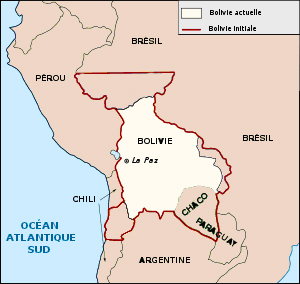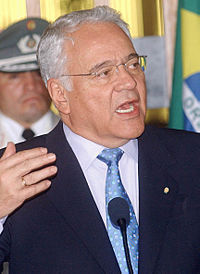The Independence
From the year 1810 to 1820, the pursuit of Spanish troops and the victory of the Mariscal Sucre (Simon Bolivar´s lieutenant), opened the way to independence, proclaimed on August 6th, 1824.
The Republic of Bolivia (in honor to the name of the liberator) was temporarily united with Peru in 1836 by Santa Cruz, but the possibility of the constitution of a powerful State worried the neighbors.
Losing territories
 As a consequence, the extensive Bolivian territory (2 340 000 km²) was consumed by many wars with its neighbors, the saltpeter war with Chile (1879-1883) does not allow the country to have access to the sea which Bolivia still claims today, the war against Brazil (1901-1903) cut the region of the Acre and of the western part of Mato Grosso. Until the war with Paraguay, (1932-1935) where Paraguay added to its territory around 200 000 km².
As a consequence, the extensive Bolivian territory (2 340 000 km²) was consumed by many wars with its neighbors, the saltpeter war with Chile (1879-1883) does not allow the country to have access to the sea which Bolivia still claims today, the war against Brazil (1901-1903) cut the region of the Acre and of the western part of Mato Grosso. Until the war with Paraguay, (1932-1935) where Paraguay added to its territory around 200 000 km².
The reshaping of the country and the political instability resulted in takeovers every year between 1850 and 1950. However, there were some stages of prosperity in the country, with the exploitation of the quinine (1830-1850), of the guano and the saltpeter (1868-1878), of latex (1895-1915), and tin (since 1880).
If the country is in debt today it is due in part to the construction of the railroads, to the financial needs of the State, and the decreased value of raw resources.
MNR
The luxurious lifestyle of a minority, opposed to the extreme poverty of the population, leads to a popular insurrection in 1952, bringing the Movimiento Nacionlista Revolucionario (MNR) to power. This had as a consequence the nationalization of the mines, the universal vote and the agrarian reform. Progressively, the regime moves away from the population, the MNR party divides, and in 1964 the army took power. They repressed the strikes with difficulty, and it was in 1967 that Ernesto Che Guevara was executed with the bullets of the Bolivian army.
The takeovers took place one after another. Only general Banzer kept himself in power for 7 years (from 1971 to 1978, and from 1997 to 2002, year in which he died). Even with the return of civil power in 1982, the country went through a succession of economic and political crises, the decade of the 80s was characterized by a great depression due to the fall of the price of tin, with the outbreak of the greatest hyperinflation of its history (11750% in 1985), as a consequence the drug economy increased.
Liberalism
At the beginning of the nineties, the country changed its path, towards economic liberalism, with the privatization of the mines and of numerous public enterprises. However, the social and economic instability is still present, the discontent of the population, and of the majority of social groups towards the governments in power is more evident every time.
 Since the year 2000 the discontent manifested in successive movements; the war against privatization of the water in Cochabamba in 2000; the war in defense of the coca plantations in the Chapare region against the army and the police on January 2003, the war against salary tax in La Paz on February 2003, and the gas war in September and October 2003 that ended with the indigenous people taking the power of La Paz, and the fall of the government of Gonzalo Sánchez de Lozada (Goni).
Since the year 2000 the discontent manifested in successive movements; the war against privatization of the water in Cochabamba in 2000; the war in defense of the coca plantations in the Chapare region against the army and the police on January 2003, the war against salary tax in La Paz on February 2003, and the gas war in September and October 2003 that ended with the indigenous people taking the power of La Paz, and the fall of the government of Gonzalo Sánchez de Lozada (Goni).
This same movement did not allow the conservative stabilization of its successor, Carlos Mesa, it obligated two possible presidents to step aside and ended imposing a transitory president, Eduardo Rodriguez Veltzé, whose main mission was to summon new presidential elections as soon as possible.
Fight for Indigenous people
It is like this that on December 18th, 2005 Evo Morales Aima is elected as the new Constitutional President of Bolivia, which signifies an important change in the politic process of Bolivia, after many years of political crises and rises of the masses, that virtually demolished the regimen of the neo-liberal “agreed democracy” and its own parties.
In 2009 Evo Morales is re-elected with a big majority (67%) and in 2010 rename the Republic of Bolivia, The Plurinational state of Bolivia.


